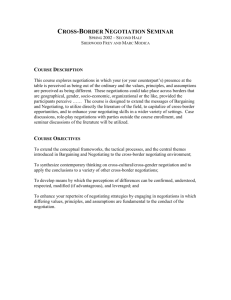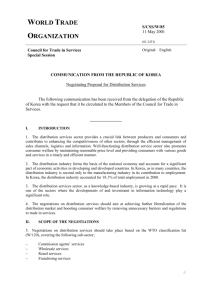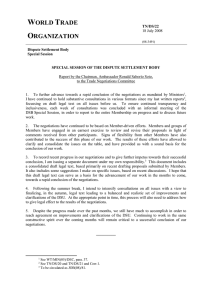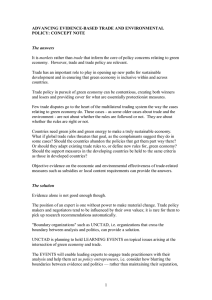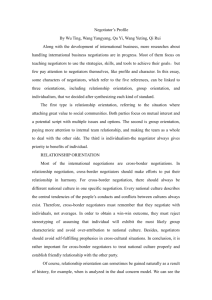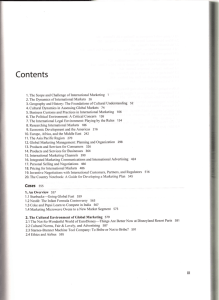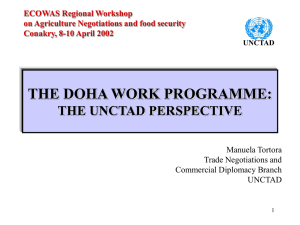Have a View Pitfalls in Asymmetric Negotiations: Kimberly Elliott*
advertisement
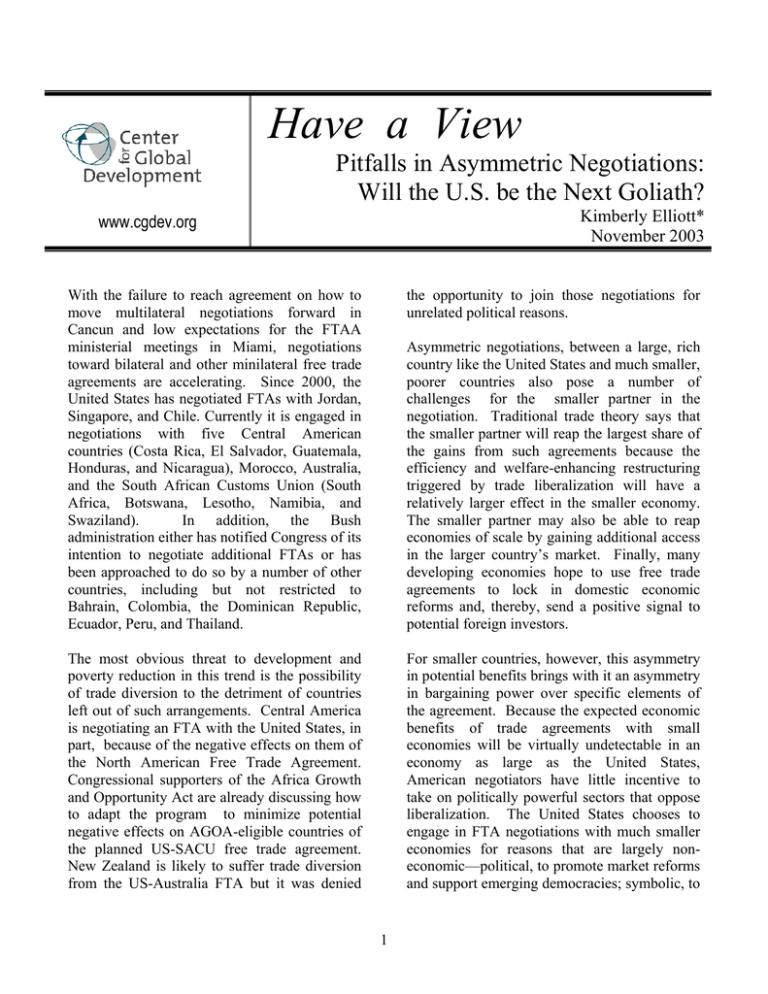
Have a View Pitfalls in Asymmetric Negotiations: Will the U.S. be the Next Goliath? Kimberly Elliott* November 2003 www.cgdev.org With the failure to reach agreement on how to move multilateral negotiations forward in Cancun and low expectations for the FTAA ministerial meetings in Miami, negotiations toward bilateral and other minilateral free trade agreements are accelerating. Since 2000, the United States has negotiated FTAs with Jordan, Singapore, and Chile. Currently it is engaged in negotiations with five Central American countries (Costa Rica, El Salvador, Guatemala, Honduras, and Nicaragua), Morocco, Australia, and the South African Customs Union (South Africa, Botswana, Lesotho, Namibia, and Swaziland). In addition, the Bush administration either has notified Congress of its intention to negotiate additional FTAs or has been approached to do so by a number of other countries, including but not restricted to Bahrain, Colombia, the Dominican Republic, Ecuador, Peru, and Thailand. the opportunity to join those negotiations for unrelated political reasons. The most obvious threat to development and poverty reduction in this trend is the possibility of trade diversion to the detriment of countries left out of such arrangements. Central America is negotiating an FTA with the United States, in part, because of the negative effects on them of the North American Free Trade Agreement. Congressional supporters of the Africa Growth and Opportunity Act are already discussing how to adapt the program to minimize potential negative effects on AGOA-eligible countries of the planned US-SACU free trade agreement. New Zealand is likely to suffer trade diversion from the US-Australia FTA but it was denied For smaller countries, however, this asymmetry in potential benefits brings with it an asymmetry in bargaining power over specific elements of the agreement. Because the expected economic benefits of trade agreements with small economies will be virtually undetectable in an economy as large as the United States, American negotiators have little incentive to take on politically powerful sectors that oppose liberalization. The United States chooses to engage in FTA negotiations with much smaller economies for reasons that are largely noneconomic—political, to promote market reforms and support emerging democracies; symbolic, to Asymmetric negotiations, between a large, rich country like the United States and much smaller, poorer countries also pose a number of challenges for the smaller partner in the negotiation. Traditional trade theory says that the smaller partner will reap the largest share of the gains from such agreements because the efficiency and welfare-enhancing restructuring triggered by trade liberalization will have a relatively larger effect in the smaller economy. The smaller partner may also be able to reap economies of scale by gaining additional access in the larger country’s market. Finally, many developing economies hope to use free trade agreements to lock in domestic economic reforms and, thereby, send a positive signal to potential foreign investors. 1 demonstrate progress in international trade negotiations at a time that the multilateral level seems stalled; precedential, to establish rules in new areas that might be replicated at the regional and multilateral levels. While important, such incentives are unlikely to be sufficient to achieve approval in the US Congress when an agreement also involves tangible losses for protected, import-competing sectors. countries of the WTO Agreement on TradeRelated Intellectual Property, US negotiators are demanding WTO-plus rules on intellectual property protections in the FTAs that it is negotiating around the world. And, at the same time that the International Monetary Fund is rethinking the relative costs and benefits of capital market liberalization, US negotiators are demanding that FTA partners abjure the use of capital controls. Thus, in bilateral (and regional) negotiations up to now, the United States is taking a largely traditional mercantilist stance, demanding farreaching concessions in agricultural, high tech, and services sectors where it is competitive and resisting concessions in sensitive sectors where it is not. So far, US negotiators are refusing to discuss agricultural subsidies and anti-dumping, key areas of interest to many developing countries, insisting that they be negotiated at the global level. In negotiations to date, they have also yielded little in sensitive agricultural sectors, such as sugar, and have insisted on strict rules of origin that reduce the value of market access concessions on textiles and apparel. And, although US negotiators have shown flexibility on phase-in periods, they demand that even countries with large subsistence agricultural sectors must open their markets for basic food crops such as corn and beans. The problem is that the transition periods are arbitrarily chosen rather than being based on development indicators, such as the proportion of the population remaining in rural areas. The smaller and the less developed the economy engaging in asymmetric negotiations, the more it must be aware of the sunk costs that it incurs almost immediately when it enters into negotiations. A major goal of many developing countries who negotiate FTAs is to attract foreign investment. But potential or existing foreign investors are likely to view it as a negative signal of a country’s commitment to reform and to openness if it fails to successfully conclude an FTA after negotiations are launched. Although it is the actual state of the local business environment that will ultimately determine the direction of capital flows in and out of a country—both foreign and domestic— and even though that environment depends more on local national actions than on any FTA, fears of negative market reactions further undercut what little negotiating leverage developing country governments have. With these dynamics in place, it is possible for a small country to find itself negotiating, not for additional gains, but to avoid losses. Depending on the outcome of the final negotiating session in December, this could be the situation that the countries of Central America face in deciding whether or not to conclude an agreement with the United States. Thus far, US negotiators have offered little beyond consolidation of the market access that the Central American countries receive under existing unilateral preference programs. But many in the business community there believe that failure to conclude an agreement would have negative Moreover, the trade agenda today has expanded far beyond reductions in tariffs and other border barriers to include a broad range of regulatory issues in areas where the optimal level or form of regulation is not obvious. In many areas, for example intellectual property protection, global harmonization of rules does not necessarily yield benefits for all and could even impede economic development. Yet, even as steps have been taken to reduce the burden on poorer 2 cooperatively can influence the course of the negotiations. So far, they have shown only that they can block action; the real challenge is in whether they can find common ground for moving forward. The initial reaction of the U.S. negotiators was to see a threat in the new coalition of developing countries. Rather than a threat, however, the evolution of developing country power represents an opportunity to build a multilateral trade system that is more balanced and therefore stronger and more sustainable. consequences for foreign investment in the region. Moreover, whether because of explicit or implicit threats from US negotiators or key congressional leaders, some in the region fear that failure to reach a deal with the United States could lead to the loss of existing preferences when those programs come up for reauthorization in a few years. From a development perspective, the multilateral system offers greater gain with less risk. The WTO meeting in Cancun demonstrated that developing countries acting *Kimberly Elliott is Research Fellow at the Center for Global Development and the Institute for International Economics. 3

